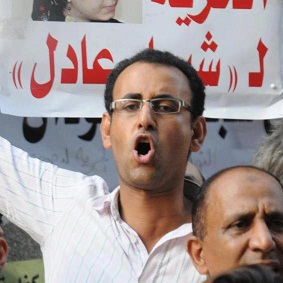
Friends of journalist Al-Hosseini Abu Deif claimed on Sunday that he was “assassinated” by the Muslim Brotherhood for documenting the groups’ assaults on protesters during the presidential palace clashes last Wednesday.
Abu Deif is currently in a coma after being shot during the violence. He was moved Saturday from Al-Zahra’a hospital to Al-Qasr Al-Aini; his condition is said to be critical.
“I don’t have a doubt that Abu Deif was targeted,” Sayed Fathy, human rights lawyer, said in a press conference held for Abu Deif at the Press Syndicate on Sunday. “His prominent role in the January 2011 revolution and constant presence in Tahrir Square is the biggest proof.”
Abu Deif was attending a course on video production on Wednesday when he received news about the clashes at the palace, Syndicate board member Abeer Saady, who also attended the course, said “he went there to document what was happening.”
Artist Mahmoud Abdel Qader, a close friend of Abu Deif, was with him when he was shot.
“When I met him, he was very happy with the photos he took of the clashes, saying he had gathered lots of evidence incriminating Muslim Brotherhood supporters,” Abdel Qader said. Abu Deif allegedly took photos of Brotherhood supporters holding firearms.
“Just as we were leaving, a new attack started so Abu Deif stayed to record it,” Abdel Qader said, “I heard the buzz of the bullet as he fell to the ground.”
Abdel Qader said that the bullet came from the pro-Morsy demonstrators, adding that all Abu Deif’s injuries were caused by the shooting. There are two possible scenarios for the shooting, Abdel Qader said; either birdshot shot at close range, or a handmade firearm shot at mid range. “In both cases, the shot was very accurate; it was perpendicular on the skull, which proves that he was specifically targeted.”
Abdel Qader added that while trying to get Abu Deif to the nearest hospital a stranger came and stole Abu Deif’s camera. It wasn’t until after they arrived to Al-Zahra’a hospital that he realised the camera was missing. Neither the camera nor the photos on it have resurfaced.
“Abu Deif spent all his savings to buy this camera,” Al-Saady said, “little did he know that it would be seen as a weapon which he must be killed for.”
Fathy said that Abu Deif was shot in an area far away from the clashes. “He was at the gas station in Khalifa Al-Ma’moun Street, an area safe from any clashes.”
Saady said that Abu Deif had received training in maintaining professional safety, adding that Abu Deif was far from the danger zone at the time of shooting.
Salem, Abu Deif’s brother, denied rumours started by some Muslim Brotherhood members claiming that Abu Deif was Muslim Brotherhood. Abu Deif was a leftist Kefaya movement member.
“If he ever protested for Khairat Al-Shater’s freedom,” Salem said, referring to a prominent Muslim Brotherhood leader who was in jail during former President Hosni Mubarak’s rule, “he did it for protecting freedoms and not for the sake of the Muslim Brotherhood.”
“This is the first assassination attempt targeting a journalist,” Saady said, “and I don’t think it will be the last. But I assure you that we will not be silenced; we will always be where the news is happening.”
The head of Al-Wattan newspaper’s Alexandria office, Haytham Al-Shaikh, was also injured in Alexandria in clashes which erupted near the governorate building on Friday.
Wednesday’s clashes left at least six people dead, according to the Ministry of Health. The Muslim Brotherhood’s supreme Guide Mohamed Badie announced on Saturday that eight of its members were killed.



